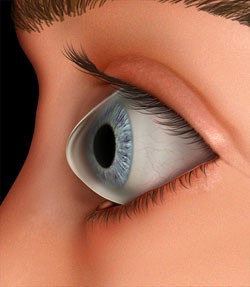What is Keratoconus?
Keratoconus, often abbreviated to "KCN", is a non-inflammatory eye condition in which the normally round dome-shaped cornea progressively thins causing a cone-like bulge to develop. This results in significant visual impairment.
Symptoms and Diagnosis
The earliest signs of keratoconus are usually blurring of vision and the need for frequent changes in eye glass prescription, or blurred vision that cannot be corrected with glasses. Symptoms of keratoconus generally begin in late teenage years or early twenties, but can start at any time. Other symptoms include:
• Increased light sensitivity
• Difficultly driving at night
• Halos and ghosting especially at night
• Eye strain
• Headaches and general eye pain
• Eye irritation, excessive eye rubbing
Keratoconus, especially in the early stages can be difficult to diagnose and all of the above symptoms could be associated with other eye problems. Simply recognizing symptoms does not by itself diagnose keratoconus. Keratoconus requires a diagnosis from a competent eye doctor who is trained in not only recognizing the symptoms but also observing signs of keratoconus through direct measurement as well as inspection of the cornea at a microscopic level using a slit lamp.
Who gets Keratoconus?
The actual incidence of KCN is not known. It is not a common eye disease, but it is by no means rare. It has been estimated to occur in 1 out of every 2,000 persons in the general population. Keratoconus is generally first diagnosed in young people at puberty or in their late teens. It is found in all parts of the United States and the rest of the world. It has no known significant geographic, cultural or social pattern. Whereas KCN has not been linked to genetic markers, it has been known to run in families. One widely accepted theory is that KCN has been linked to aggressive eye rubbing. Much like that of habitual fingernail biting, eye rubbing is a learned behavior and thus can run in families as well.
What happens?
 The cornea is the clear window of the eye and is responsible for refracting most of the light coming into the eye. Therefore, abnormalities of the cornea severely affect the way we see the world making simple tasks, like driving, watching TV or reading a book difficult.
The cornea is the clear window of the eye and is responsible for refracting most of the light coming into the eye. Therefore, abnormalities of the cornea severely affect the way we see the world making simple tasks, like driving, watching TV or reading a book difficult.
In its earliest stages, keratoconus causes slight blurring and distortion of vision and increased sensitivity to light. These symptoms usually first appear in the late teens and early twenties. Keratoconus may progress for 10-20 years and then slow or stabilize. Each eye may be affected differently.
Living with KC
People react differently to the news that they have keratoconus. Lack of knowledge often creates fear, so learn all that you can about this condition. Ask questions and discuss your concerns with your doctor and others who have keratoconus. This will be both enlightening and reassuring. While it is important that you accept keratoconus as a fact in your life and realize that you have to adapt to it, it is essential for you to understand that adapting is not surrendering. From a medical standpoint, the most important thing you can do is to keep in touch with your eye care practitioner and follow his/her instructions.






